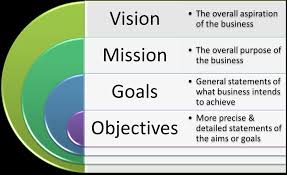Looking for some examples of Business Objectives and for-profit goals? Your first progress will be determined by your business objectives. Additionally, they will evolve as your business grow. Some businesses believe that a business target needs to be specific, quantifiable, reachable, and time-based in order to be most effective. Creating defined business objectives may be beneficial for both large and small businesses.
You can accomplish your mission statement and long-term corporate vision by setting clear business objectives. These goals can be anything from financial ones to ones that are special to the organization.
Your unique goals and the business activities you are conducting will determine the type of goal you create. Short-term targets are a good choice if your goals have a specific time limit, whereas longer-term goals have their own special frameworks.
However, if you’re not sure where to begin, you might profit from these examples of business objectives in this article.
Table of Content:
- Importance of Business Objectives and Aims
- Survival, Profit, Growth, Sales Revenue, Behavioral Theories & Business Operations
- What determines Business Objectives?
- How Useful are Mission Statements?
Tips: Examples of Business Objectives – You invest £2,000 in startup costs and anticipate paying around £200 per month in company expenses. You must first make back that £2,000 before you can start making more than £200 per month in order to turn a profit.
Business Objectives and Aims:
All businesses have examples of business objectives. These are the goals of the business. They are the outcomes or targets that the business wants to gain in order to achieve its business aims.
The business objectives can be derived from its aims. One example of business objectives is a business supplying recycled wood for buildings that might aim to be the most important supplier of the service in an area and the first name that everyone thinks of when buying these products. The objective might be to be supplying 40 percent of all recycled wood in the area within the next three years.
A business should have clearly stated goals. These will enable the business in being crystal clear about its goals. How well a company accomplishes its goals can be used to gauge how well it is performing. One more example of business objectives is, that a business might have the objective of increasing sales by 20% over three years. If it had increased sales by only 5% then it might conclude that it has been unsuccessful.
It is often argued that businesses must set objectives that are SMART. This means that they should be:
- Specific – Clearly defining the goal being pursued
- measurable – in order to determine whether they have been attained.
- agreed – be accepted and understood by all parties concerned.
- realistic – able to be achieved by the business taking into account its resources, competition, markets, etc.
- time-specific – specify a deadline for when they should be done.
Business goals can be a crucial tool for bringing a company’s aims and vision together. Objectives can help:
Examples of Business Objectives:
- Increase revenue
- Recruit and retain high-quality employees
- Enhance customer satisfaction
- Improve company culture
- Maximize workplace safety
- Develop leadership
- Expand productivity
- Increase product quality
- Encourage innovation
Most Important Business Objectives:
The rules that serve as the basis for your business planning are established by having a thorough list of corporate objectives.
The most Important Examples of Business Objectives for Small Businesses are:
- Gaining and Maintaining Profitable
- Productivity of Resources and Humans
- Outstanding customer service
- Core Values that are Mission-driven for Employee Attraction and Retention
- Continual Growth
- Keeping a Strong Cash Flow
- Adapting to Change
- Finding the Right Clients
- Keeping up with the competition
1. Corporate Aims – Examples of Business Objectives

A company’s overarching goal is to achieve its corporate objectives. Long-term, this is what the company seeks to accomplish.
It is likely that different types of businesses will have different aims. For example, a small plumbing business might have different aims from the Coca-Cola organization. Business objectives and aims are likely to be different at different times. A business might have a number of business aims, not just the obvious one of making a profit, although not all organizations might suggest that they have this aim.
2. Survival – Examples of Business Objectives
From time to time all businesses, regardless of their size and status, will consider survival important.
Early stages of trading – The majority of businesses start out small, establish themselves, and then expand. The survival of a new company in its first several months of operation will definitely make its owners delighted. When a company first starts trading, it may run into a number of issues, including:
Examples of Business Objectives:
- a lack of experience
- a lack of resources
- competition from established firms
- unforeseen problems such as unexpected cost
- limited recognition by the customer
Also, in the early-stage decision-makers might make mistakes. As a result of this uncertainty, the most important business objective might be to survive in the initial stage of trading, such as the first three years.
When trading becomes difficult – During a recession, here are examples of Business objectives that a business could face falling demand, bad debts, and low confidence. Many well-known enterprises went out of business during the UK recession of 1990–1992. In 1992 around 73, businesses collapsed. Improved trading conditions reduced this figure to around 40.000 in 1998.
Due to pressure from rivals, declining demand for their products, or the results of bad actions, certain businesses or sectors may have challenges. Arguably the objective of Apple, the computer manufacturer, in allowing Microsoft, a rival, to take a stake in its operation in 1997 was to protect the company during a difficult period.
The threat of takeover – Firms sometimes become targets for other firms to take over. When this happens the survival of the firm in its existing form may be the main business objective. One way to achieve this is to persuade the owners (shareholders) not to sell shares to the person or company bidding for them.
Except potentially for sole proprietors, it seems unlikely that survival would continue to be the overriding goal in the long run. Potential business owners frequently seek need more.
3. Profit – Examples of Business Objectives:
It is often argued that the main objective of private sector businesses is to make a profit. It is suggested that some businesses try to Profit Maximise. This is achieved where the difference between the total revenue earned by the business from selling its products and the total costs of those products is the greatest.
It might be reasonable to believe that businesses want to make the most money feasible. In practice, a business is more likely to a satisfactory level of profit as an objective. This is known as SATISFICING. Why is this likely to be a more reasonable objective?
Objectives of small firms – Owners of small firms may not want to expand their output to a point where their profits are maximized. This may be because:
- It involves employing more work, making more decisions, and working longer hours
- They may want to keep their turnover below the VAT threshold, avoiding the need to charge their customers VAT and filling in the VAT return
- They are content with their current standard of living and a reasonable amount of profit.
Information – In practice, it may be difficult to identify precisely the level of output that will maximize the profile. For a business to do this it must be able to measure all of its costs at every possible level of production. It must also be able to estimate accurately the prices it can charge and predict the likely demand at these prices.
Other objectives – A business might sacrifice short-term profit maximization for long-term profits. This might explain why a firm lowers its price initially to build a market share and then increase its price when competitors have left the market. It might also account for firms operating in the short term at a loss. In this case, the owners may be optimistic that in the future sales pick up.
4. Growth – Examples of Business Objectives

Many businesses pursue growth as their main objective. People in business say that for businesses to survive, they must expand. Failure to grow might result in a loss of competitiveness decline in demand and eventual closure.
A company may eventually be able to enjoy some monopoly power and increase its price if it is successful in expanding and taking over the market. A company can diversify its business and lower its risk by expanding. It can launch new items and sell to alternate markets. If one market or product fails it will have a range of others to fall back on. Firms can expand economies of scale if they grow large enough.
They will be able to be more cost-effective and efficient as a result of this. A number of people involved in business activity might benefit from growth.
a). Employees may find their jobs will be more secure
b). Managers and directors will tend to have more power and status. Some examples of business objectives, a director of a large oil business are likely to enjoy more power and recognition than the director of a small manufacturer.
c). The salaries of directors and the chairperson are often linked to the size of the firm.
d). The owners of companies might have mixed feelings about growth. On the one hand, growth often means that current profits have to be invested to fund the expansion.
However, growth might generate much higher profits in the future, which will benefit the owners.
Examples of business objectives include:
Businesses track both long- and short-term growth. Growth can be seen in a variety of ways, including increased website traffic, social media followers, revenue, and product sales.
5. Increasing Shareholder Value:
Increased shareholder value is a common goal of public limited enterprises. This means they run the business in a way that will result in an increase in share price and an increase in dividends. Shareholders benefit when the share price goes up because when they sell their shares they may make a capital gain (a profit on the sale).
However, other corporate goals are directly related to shareholder value. The share price will go up if there is an increase in demand for the shares, ie more investors want to buy them. An increase in demand will result if the company is expected to grow and become more profitable. Therefore, by growing the company and making more profit, shareholder value will increase.
Companies are required by law to include a shareholder value metric in their annual reports.
6. Managerial Objectives & Examples of Business Objectives:

Sometimes the managers of a business are able to pursue their own objectives. There must be some separation of ownership and control for this to occur. In other words, the owners of the company do not necessarily control the day-to-day running of it.
This may be possible when there is a very large number of join owners as in a public limited company. Each owner has such a small part of the firm that he or she is able to exert little control over its running.
As a result, management takes control and runs the company according to their own objectives. These vary depending on individual managers, Some common examples of Business Objectives might be to:
- Maximize personal salary
- Maximize their departmental budgets
- improve their status and recognition
- Maximize their leisure time and delegate as much work as possible
- Maximize fringe benefits, such as expense accounts for entertaining or company car
If managers are seen by owners to be abusing their power they are likely to be fired. To protect their positions managers often pacify owners by ensuring that the business generates enough profit to keep them satisfied. Profit may also be important to managers if their salaries are linked to profit levels.
7. Sales Revenue Maximization:
SALES REVENUE MAXIMISATION is where businesses try to gain the highest possible sales revenue. Employees whose pay is dependent on sales will favor this goal. Managers and sales staff are examples of staff paid according to the sales revenue which they generate. Maximizing sales revenue is distinct from doing so in order to maximize profits.
Examples of business objectives include:
Any business must continue to be profitable on a constant basis. Without constant earnings, businesses cannot be profitable. A smart technique to monitor a company’s sustainability is to measure its revenue.
8. Image, Reputation, and Social Responsibility:
Businesses have recently begun to recognize the value of maintaining a positive public image. Many have also realized the advantages of being accountable to a wider variety of stakeholders, including customers, employees, and suppliers. Why has this happened? There are some examples of business objectives are:
- Legislation has been passed that favors consumers
- There have been changes in social attitude
- Businesses now have to take other people’s wants into consideration due to intense competition.
Customers – Companies with household names such as Heinz Coca0Cola, Kellogg’s, ford Cadlbury’s, and Sainsbury’s would not wish the general public to think badly of them. Some companies have made serious efforts in recent years to improve their image. Some examples of Business objectives, Skoda, the car manufacturer, has in the past had an image as a producer of ‘budget’, or unfashionable’ cars. It has made an effort to shed this reputation by making use of the name of its new owner. VW.
If companies don’t consider the needs of customers when they are up against the competition, they risk losing sales. Increasingly, firms are giving free after-sales services, replacing unwanted goods with questions, and training their staff to deal with the public.
Examples of business objectives include:
Customer satisfaction is always put first in every firm. To make sure they’re leaving the appropriate impression and fostering loyalty, some businesses routinely poll their customers.
Employees – Government and EU legislation and employee representative groups have influenced how businesses treat employees. To secure workers, a number of laws have been passed. One more example of Business objectives legislation that affects workers is the Disability Discrimination Act, of 1996. This is designed to reduce discrimination by businesses against disabled workers.
One effect of the legislation is that it protects companies with high standards of responsibility from those competitors who have little regard for health and safety at work.
Unscrupulous firms will not be able to lower costs by neglecting health and safety because they will have to keep up with the law.
Trade unions have argued for the rights of the workforce for many years. They have aimed to improve social facilities, wages, and working conditions.
Suppliers – Some firms have benefited from good relations with suppliers of raw materials and components. some examples of business objectives are in manufacturing, where companies are adopting just-in-time manufacturing.
As a result, businesses only manufacture when they have an order, and raw materials and component stockpiles are only brought into the factory as needed. Reliable and efficient suppliers are needed by firms if they order stocks ‘at the last minute. Maintaining good relations with suppliers is likely to help this process.
Other examples of business objectives for good relations might be prompt payment to suppliers or regular meetings to discuss each other’s needs.
9. Behavioral Theories – Examples of Business objectives:

BEHAVIORAL THEORIES assume that business objectives are not determined by owners and managers alone. They suggest that other stakeholders, such as the government, consumers, and pressure groups, may affect the firm’s objectives. The objective a company has will depend on the power of these groups to influence decisions. It is argued that groups inside and outside the business have certain minimum goals. Some examples of Business objectives are:
- To keep their interest in the company, the owners will need a specific level of earnings.
- Workers will demand a minimum level of pay and acceptable working conditions if they are to be retained in employment.
- Suppliers will want regular contracts, reasonable lead times, and prompt payment
- Managers will insist on enough resources to carry out their tasks ( there are examples of business objectives – one might include an appropriate allowance).
- The corporation will be required by the government to abide by the law and pay taxes.
- Customers will demand quality products at reasonable price
- Pressure groups, such as environmentalists, will try to protect their interests, eg, avoiding pollution.
In practice, the group with the most influence will achieve its objectives. In the 1990s animal rights pressure groups, such as Lynx, persuaded customers to buy fewer fur products. Some businesses saw sales reduced as a result and others switched to the manufacture of synthetic fur clothing.
Managers and owners of large businesses sometimes pursue a policy of delayering or downsizing – reducing the number of tiers in the business hierarchy. They are convinced that such measures will make their business more efficient and reduce costs. This results in many employees losing their jobs.
The influence of a group may change over time or if the organization of business changes. Examples of Business objectives, increased legislation might give employees more influence over holidays and hours worked. A management buyout is likely to give managers more say in the business.
10. Business Operations –

Businesses sometimes set objectives for the operation of the organization. There are some examples of Business objectives that a business might decide that it needs to diversify its product range. A company might be operating with a small, relatively specific type of product. If there was a decline in demand for these products, if there was a sudden increase in competition, or if the products become out of date due to changes in technology, the business might fail.
Diversification is one way in which a business can protect itself against declines in certain markets. This is sometimes the reason why businesses merge with others in different markets, known as lateral integration.
A business might also decide to change the focus of its organization. It might, there are examples of Business objectives, decide to focus on its main area rather than operating in a number of areas. This is often the reason why businesses divest themselves of or sell parts of, their organization to concentrate on their core activities.
Examples of business objectives include:
Making ensuring that your company’s logistics are in order is one of your operational goals. For instance, it can entail making sure that a manufacturer’s supply would ship at the same time each month. These goals keep the business operating properly.
Tips: If you start a business that consumers frequently need, like a hair salon, you might also want to develop a plan for keeping the clients you already have. There are one other Examples of Business Objectives, you could prioritize client service or implement a loyalty program to foster strong bonds.
11. Example of Business Objectives in the Public Sector:
As a result of government policy in the last two decades of the twentieth century, public sector organizations changed their objectives. Historically, the main objective of public sector businesses was to supply a public service. For example, previously state-owned organizations, such as British Rail and British Gas, had to supply services in isolated regions that were unprofitable. Profit was not really a motive for public sector organizations. Many made losses.
In the 1990s public sector organizations aimed to offer their services in a more “business-like” way. The government expected them to operate efficiently and produce a cost-effective and quality service.
Some had fairly substantial ‘surpluses’, part of which are paid to the Treasury. Public sector organizations adopted many private sectors business techniques, such as marketing, business planning, budgeting, and investment appraisal.
Examples of Business objectives might be colleges trying to attract students to obtain government funds or NHS trusts competing to sell services to fund hold GPs.
For some public sector organizations, performance targets were set to ensure that a ‘good’ standard of service was supplied. Examples of business objectives, hospitals aimed to reduce waiting lists for beds and operations. Councils had their budgets cut to ensure that waste was minimized. Sixth-form colleges were instructed to improve efficiency in the delivery of their education services.
The performance rates of many public sector organizations are widely published. National league tables are compiled for crime and detection rates, exam results, and truancy rates. These tables are intended to increase competition in the public sector and provide performance information to the general audience.
Examples of business objectives include:
Employee productivity and performance: A company’s workforce is its lifeblood. Ensuring employee productivity boosts sales and elevates client pleasure. Efficiency and productivity are ensured by measuring employee satisfaction and defining goals for each team.
Tips: You can better manage your to-do list if you set out to stay productive and have a plan on how. One of some Examples of Business Objectives is that You might discover is project management tools that might guide you in keeping track of your tasks and setting priorities.
What determines Business Objectives?
There is a number of factors that can influence the choice of objective. There are some examples of business objectives are:
The size and status of the business – Many small businesses might be prepared to achieve only a satisfactory level of profit or survival in difficult times rather than expand or make a large profit. Large companies might be more concerned about growth and perhaps market domination.
A business that is starting up is likely to be more concerned with survival. Later, when it has become established, other objectives such as growth may be more important.
The power of stakeholders – As explained earlier, behavioral theorists argue that the stakeholder group which dominates the business is likely to have the most influence over objectives. Shareholders are likely to more concerned about profit. Outside stakeholders might be more concerned with social objectives, such as the impact of production on the environment.
Ownership – examples of business objectives: The ownership of the organization can influence objectives. Sole traders might have different objectives from larger public limited companies or they could be the same.
There are some examples of business objectives are, a single owner might want to make as much profit as possible, just like the many owners of a plc.
However, a plc might be very concerned about image, particularly before a share issue, whereas a sole trader may see this as a fairly unimportant objective. The business’s affiliation with the public or private sectors is also probably to have an impact.
Public sector organizations, whilst increasingly becoming aware of the need to be efficient and make a surplus, might be more concerned about their impact on the public and society than some private organizations.
Long and short-term examples of business objectives – Might be different. In the long run, businesses must make a profit to survive. In the short run, however, a business might be prepared simply to break even, particularly if trading conditions are difficult. There are other reasons why firms might sacrifice profit in the short run.
There are some examples of business objectives that firms entering a new and expanding market might take time to become established and might accept losses initially. Also, businesses seeking to invest in expensive projects that will lead to greater profit at a later date might sacrifice short-term profit.
Some more examples of business objectives are, British Biotechnology plc, the pharmaceuticals company that started in 1986, had still not made a profit by 2003. Many mobile phone companies accepted large initial expenses or losses to set up in the market, hoping to make a profit only after a number of years.
External and Internal Pressures – examples of business objectives: Pressures from outside business can affect objectives. New legislation may force a business to change its behavior and take into account the effect of its activities on the environment or employees, the landfill tax, for example, might have encouraged greater recycling. Changes in employee legislation could increase costs and change profit objectives.
Changing market trends can also influence objectives, Increasing demand for products may encourage a business to grow and expand into new areas of production.
Examples of business objectives: Internal pressures might also play a part. For example, the appointment of a new chairperson might completely alter the foals of the organization. A change in production techniques or a delayering of management might also affect objectives.
Risk – Examples of business objectives: Pursuing some objectives might be riskier than others, for example, trying to achieve growth by entering new and unknown markets could be very risky for a business.
Some businesses are happy to take risks because the potential rewards outweigh the costs involved. Others are risk-averse. It might be argued by some that the move by Morrisons in 2003 to take over Safeway was risky because the company has little experience in integrating with such a large organization.
Corporate and business culture – The values and norms of behavior developed by a business over time, and its corporate culture are likely to influence its objectives. A business that has a caring corporate culture and is competitive culture is one examples of business objectives.
One of some Examples of Business Objectives – You must make sure you have at least that much cash ready if your monthly spending is £500. Additionally, budget for and preserve money for unforeseen or urgent costs like damaged equipment.
How Useful are Mission Statements?
Businesses are increasingly producing Mission statements. These include a description of the overall business aims. They tend to be aimed at stakeholders in the business. So they are often found printed in the annual report and accounts of public limited companies.
Examples of Business Objectives include information for all stakeholders, including employees shareholders, and also customers. They usually express the aims of the business in ‘qualitative terms’, such as emphasizing the desire to be the best in the business or to become the ‘best in the field’. Further, they frequently contain the company’s beliefs and guiding principles as well as maybe its corporate culture.
Sometimes mission statements are brief. They might be a line or two stating the main priority of the business. This will help people to identify and remember the main purpose of the business. Or they might be a short statement or a page which can be displayed in place such as reception areas.
They can then be viewed by staff, customers, and suppliers, showing what the business is trying to achieve. They might include a variety of features about the aims of the business, including its main purpose and how it might evaluate success. In some circumstances, it might even go so far as to provide information about the company’s goals, indicating targets or outcomes.
Importance of Mission Statement:
It could be argued that it is important for all businesses to have a mission statement. There are some examples of Business objectives, and why a mission statement is important:
- help the business to focus
- provide a plan for the future of a business
- Make the goals of the business obvious to all stakeholders.
However, it has been suggested that mission statements are little more than a publicity stunt. Indeed, there is evidence to suggest that many of the statements are predictable and bland. The vast majority of organizations have mission statements and most of them contain common themes such as, there are some examples of business objectives are;
- ‘our aim is to maximize shareholder value.
- ‘we will focus on customer need’.
- ‘we aim to become the premier supplier of …’
- ‘in pursuit of excellence.
Whether or not a mission statement actually affects the way a business operates is debatable. How many staff can remember the company’s mission statement for example? A further problem is that the aims and objectives of the business are not always easy to distinguish from the mission statement.
Sometimes businesses state that their main aim is growth. By placing outcomes in the statement it could be argued that these are then more specific and achievable goals or objectives.
Tips: One of examples of Business objectives for a business plan is to create a unique brand and overall marketing strategy. You may, for instance, use social media and spend money on paid advertising.
What to Read Next:
Business objectives examples – business objective examples – examples of business objectives- business goals and objectives examples – what is one example of differentiating business objectives- how to write business objectives examples- what are business objectives examples-what is a business objective example – example of business objective – types of business objectives – what is business objects – who decides the team pi objectives business value scoring – objective for business – business goals and objectives examples





